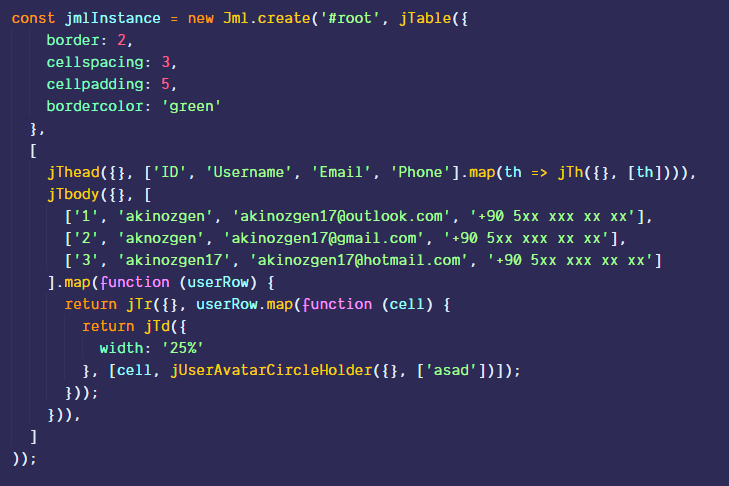Notice: I did some updates and documentation is not capable enough to explain all capabilities. Best way to understand is digging around examples which is at the below of this documentation.
JaMaL stands for JML which is javascript markup language. "a"'s are just filling.
Jamal (Arabic: جمال Jamāl/Ǧamāl ) is an Arabic masculine given name, meaning "beauty". The use of this name is widespread across the Muslim world. In Egypt the name is pronounced [ɡæˈmæːl] and so is normally spelled Gamal . Tunisians may spell it Jamel. Source
Table Of Contents
- Philosophy
- Basic Usage
- Get Started
- To-do
- Advanced Usage
- Comng Soon
Philosophy
JaMaL is for creating html content with javascript functions. A "J" function takes three arguments which are attributes, children and debug config. Just this. No need to know fancy observers, reducers or something like that.
Why "JaMaL"?
Obviously i'm not arab or arab fan or things like that. I made a library called jml.js which stands for javascript markup language. I wanted to remake of that library and didn't wanted to find a new name. But jml and jml.js already picked on npm so i needed to little changes and thats where JaMaL came from. I just filled gaps with a's. After that i needed a new logo with that middle eastern name so i used Launchaco Logo Maker to make a logo that makes sense with new name.
Logo Credits:
font name: amita-regular
font link: https://fonts.google.com/specimen/Amita
font author: Eduardo Tunni
font author site: http://www.tipo.net.ar/
icon designer: Brittnee Snodgrass
icon designer link: /brittnee.snodgrass
What is it for?
Simply; creating dom nodes with programmatic way. Complex way: There soo many javascript frameworks hanging around and i wanted to make a protest to this community. You don't need a framework for every thing, just use jQuery or write yourself.
Simply; you have an ajax call and this call appends new content to your DOM. Don't write html yourself, just use a jml tag function to render content.
Whom is it for?
Of course this is not for huge projects. It was just a hobby to me so i hope same for you to.
Basic Usage
I'm don't know how to describe its lifecycle in english. I'm not best at it. But i think it explains itself:
JMLInstance
JMLInstance returns an object that has five elements. They are:
body: dom element that selected by given selector.render: render method renders markup tobodyclear: truncatesbodygetRef: returns dom element by provided_id._idis randomly created by jml.markup: created dom content.
jSomething functions
jSomething functions are totally html tags can be used as functions.
For example html has article tag, jml has jArticle tag. Also jSomething tags can be created by given custom tags in jmlInstance.initialize method.
jSomething methods also has config options. Currently it has just two options, debug and inspect.
Debug option gives information about jSomething function runtime, inspect options puts debugger in that jSomething method.
Accessing refs
Your jmlInstance object has property called getRef. Which is a function, takes string for _id attribute.
This method returns a reference from actual dom tree so you can easily inspect your actual dom.
Usage:
jmlInstance; // output // <th _id="_c0dq6bv4v">Username</th>Nesting
Everything is jSomething method, a jSomething method takes an argument which can be another jSomething method. So you need to understand nesting carefuly. Also all jSomething methods returns an HTMLElement object
There is some complex example:

And thats actual render:

jSomething functions overloads (ex. jTable)
jTable: HTMLElement;jTablechildren: string|HTMLElement: HTMLElement;jTablechildren: Array<string|HTMLElement>: HTMLElement;jTableattributes: Object<string, string|number|Callbacks
A jSomething functions second args (which is an array) can be mapped with .map, .filter or functions like that. One obligation: it must be an array after all.
Get Started
Clone project to you local machine. Install dependencies with npm install or yarn command.
CDN
NPM Package
$ npm install jamalDevelopment
Run yarn watch command and open http://localhost:8080 from your browser and get started. No not modify src/index.js unless you know what you're doing. src/index.js file is main jml library file. If you want to use jml (not developing it) import another script or write it inside html file.
Examples
| Bootstrap 4 Boilerplate | Promise API Call | Components Example | Character Counter |
|---|---|---|---|
 |
 |
 |
 |
| 1.2.0 Updates |
|---|
| See On Codepen |
To-Do
- onEvents for jSomething methods.
- NPM package update.
- Remove customTag necessity.
- More flexible parameter passing for jSomething functions.
- Promise based async children
and parameterssupport. - Two way binding for children.
- HTML to JML tool.
